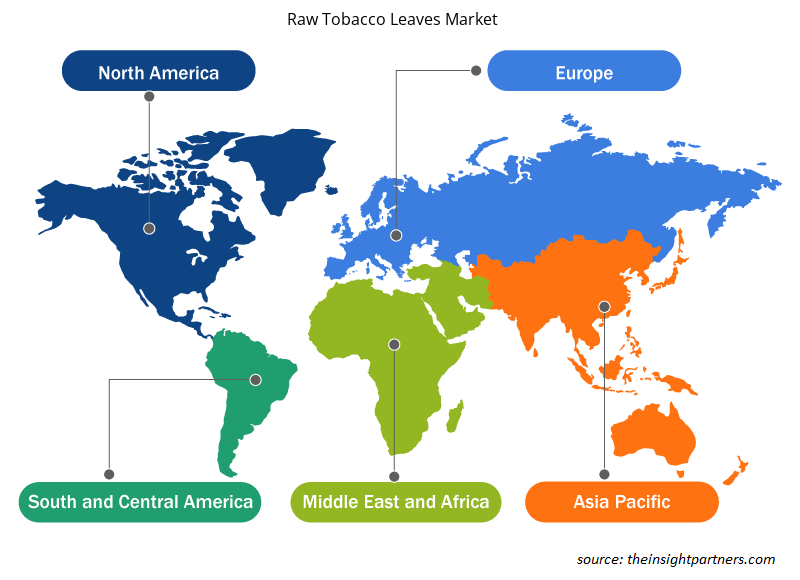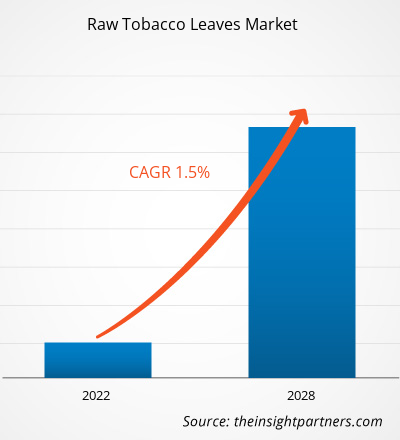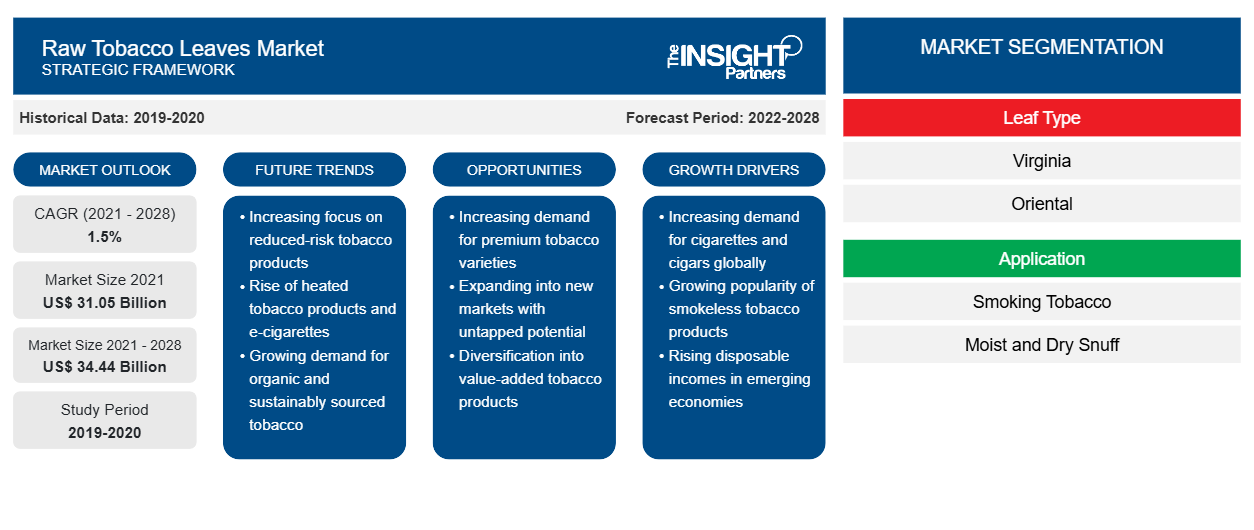Der Markt für Rohtabakblätter wurde im Jahr 2021 auf 31.045,19 Millionen US-Dollar geschätzt und soll bis 2028 34.436,28 Millionen US-Dollar erreichen; von 2021 bis 2028 wird mit einer durchschnittlichen jährlichen Wachstumsrate von 1,5 % gerechnet.
Tabakprodukte werden durch Trocknen von rohen Tabakblättern hergestellt. Tabakblätter enthalten Nikotin und ein flüchtiges Alkaloid, das die Gehirnfunktion stimuliert. Darüber hinaus wird erwartet, dass kontinuierliche Innovationen bei Tabakprodukten und staatliche Vorschriften für den Verkauf von rohen Tabakblättern im Prognosezeitraum lukrative Möglichkeiten für aktive Anbieter schaffen werden.
Im Prognosezeitraum wird der asiatisch-pazifische Raum voraussichtlich den größten Anteil am weltweiten Markt für Rohtabakblätter haben . Laut dem Asia-Pacific Heart Network weist die Region die höchste Raucherquote der Welt auf. In der Region werden jährlich 2,3 Millionen Todesfälle aufgrund von tabakbedingten Krankheiten verzeichnet, was etwa der Hälfte der jährlich 5 Millionen tabakbedingten Todesfälle weltweit entspricht. Darüber hinaus werden Verbesserungen der Einzelhandelsinfrastruktur und intensive Markenkampagnen namhafter Tabakunternehmen wie Philip Morris International und British American Tobacco in Schlüsselmärkten wie China, Bangladesch, Indien und den Philippinen voraussichtlich die Marktexpansion in dieser Region unterstützen.
Die anhaltende COVID-19-Pandemie hat den Status des Marktes für Rohtabakblätter drastisch verändert. Die Pandemie hatte den größten Einfluss auf die Produktions-, Logistik- sowie Tourismus- und Reisebranche. Der Ausbruch zwang die Regierungen zahlreicher Länder, Ausgangssperren zu verhängen , um die Ausbreitung des Virus einzudämmen. Daher haben mehrere Unternehmen Ausfallzeiten und einige Unternehmen arbeiten aus der Ferne, was zu geringer Produktivität und Einkommen führt. Die COVID-19-Pandemie hat zu erheblichen gesellschaftlichen und wirtschaftlichen Störungen geführt und zur Schließung von Geschäften, Fabriken und Büros geführt. Die Krise führte auch zu Beschränkungen bei Herstellung, Vertrieb und Reisen. All diese Faktoren wirkten sich während der anhaltenden Pandemie negativ auf Unternehmen, Betrieb, Cashflows und Finanzlage aus. Die Rohtabakblätterindustrie wuchs vor dem COVID-19-Ausbruch erheblich. In letzter Zeit ist sie jedoch instabil, da die Verbraucher bei ihren Einkäufen wählerisch sind. Der Zustand hat die Nachfrage nach Tabak erheblich gestört. In mehreren Ländern werden Tabakprodukte als nicht lebensnotwendige Artikel eingestuft, was die Nachfrage nach Rohtabakblättern und Tabakprodukten weltweit verringert hat. COVID-19 ist eine Atemwegserkrankung und verursacht Atemprobleme. Daher vermeiden die Menschen den Konsum von Tabakprodukten. Außerdem wird Tabakrauchern geraten, mit dem Rauchen aufzuhören, um das Risiko einer Infektion mit dem Virus zu senken. Daher wird erwartet, dass der COVID-19-Ausbruch das Wachstum des Marktes für Rohtabakblätter in Zukunft bremsen wird.
Passen Sie diesen Bericht Ihren Anforderungen an
Sie erhalten kostenlose Anpassungen an jedem Bericht, einschließlich Teilen dieses Berichts oder einer Analyse auf Länderebene, eines Excel-Datenpakets sowie tolle Angebote und Rabatte für Start-ups und Universitäten.
-
Holen Sie sich die wichtigsten Markttrends aus diesem Bericht.Dieses KOSTENLOSE Beispiel umfasst eine Datenanalyse von Markttrends bis hin zu Schätzungen und Prognosen.
Markteinblicke
Steigender Konsum von Tabakprodukten in Entwicklungsregionen
Die Nachfrage nach Tabakprodukten steigt in Regionen wie dem Asien-Pazifik-Raum und dem Nahen Osten und Afrika stark an. Der Nachfrageanstieg im Asien-Pazifik-Raum ist auf die steigende Bevölkerung, das steigende Einkommensniveau der Verbraucher und laxe staatliche Regulierungen zurückzuführen. Der Markt in Schwellenregionen wie dem Asien-Pazifik-Raum und dem Nahen Osten und Afrika dürfte im Prognosezeitraum ein beträchtliches Wachstum verzeichnen. Das Wachstum der Einzelhandelsinfrastruktur und groß angelegte Markenkampagnen führender Tabak produzierender Unternehmen wie Philip Morris International und British American Tobacco in Hauptmärkten wie Indien, China, Bangladesch und den Philippinen dürften das Marktwachstum im Asien-Pazifik-Raum in den kommenden Jahren ankurbeln. Die Bemühungen multinationaler Tabakunternehmen, die Tabakproduktion in den Schwellenregionen anzukurbeln und auszubauen, sollen den steigenden Bedarf ihrer Auslandsmärkte an leicht verfügbaren und günstigeren Tabakblättern decken.
Der asiatisch-pazifische Raum ist einer der weltweit bedeutendsten Tabakproduzenten und -konsumenten, angeführt von Ländern wie Indien und China. Vier der weltweit größten Tabakunternehmen sind Japan Tobacco Inc., China National Tobacco Corporation, ITC Limited und PT Gudang Garam Tbk , und sie haben ihren Sitz im asiatisch-pazifischen Raum. Darüber hinaus ist China der größte Markt in der Region, da ein erheblicher Prozentsatz der Bevölkerung Tabakprodukte konsumiert. Laxe Regulierungen in Ländern, wie beispielsweise das Verbot des Konsums von Tabakprodukten an öffentlichen Orten in Indien, und die zunehmende Verfügbarkeit von Tabakprodukten in modernen Einzelhandelsgeschäften in der Region treiben das Wachstum des Marktes für Rohtabakblätter im asiatisch-pazifischen Raum aktiv an.
Einblicke in die Blattart
Basierend auf der Blattart ist der globale Markt für Rohtabakblätter segmentiert in Virginia , Oriental und Sonstige. Das Virginia- Segment wird im Prognosezeitraum voraussichtlich den größten Marktanteil halten. Virginia oder flue-cured Tabak ist wegen seiner goldgelben bis tieforangen Farbe während der Trocknung auch als „heller Tabak“ bekannt. Er wird typischerweise eine Woche lang in beheizten Scheunen getrocknet und hat ein leichtes, lebendiges Aroma und Aroma. Er wächst außergewöhnlich gut in regnerischen Gebieten wie Georgia (USA), Südbrasilien und Simbabwe und ist in fast jeder Zigarettenmischung zu finden. Virginia-Tabak ist der weltweit am meisten konsumierte Tabak. Er wird auf verschiedene Arten angebaut, geerntet, getrocknet und verarbeitet. Sein Nikotingehalt liegt zwischen 1 % und 4 % und sein Zuckergehalt zwischen 4 % und 25 %. Virginia-Tabak enthält viel Zucker und macht den Zigarettenrauch süßer.
Anwendungseinblicke
Der Markt für rohe Tabakblätter ist je nach Anwendung in Rauchtabak, feuchten und trockenen Schnupftabak und andere unterteilt. Das Segment Rauchtabak wird im Prognosezeitraum voraussichtlich den größten Marktanteil halten. Rohe Tabakblätter werden hauptsächlich zum Rauchen in Produkten wie Zigaretten, selbstgedrehten Zigaretten, Zigarren, Wasserpfeifen, E-Zigaretten und E-Zigaretten verwendet. Beim Tabakrauchen wird der Rauch eingeatmet, der durch das Verbrennen trockener oder getrockneter Tabakblätter entsteht. Die biochemisch aktiven Bestandteile des Tabaks, wie Nikotin und TSNA, werden bei der Verbrennung freigesetzt und können über die Lunge aufgenommen werden. Tabak ist der Hauptbestandteil von Rauchtabakprodukten. Virginia, Burley und Oriental sind drei Tabaksorten, die häufig zur Herstellung von Tabakprodukten verwendet werden. Laut einer Umfrage des Behavioral Risk Factor Surveillance System aus dem Jahr 2016 waren 44,3 % der derzeitigen jungen erwachsenen E-Zigarettennutzer nie Raucher, bevor sie E-Zigaretten ausprobierten. Darüber hinaus nutzen immer mehr junge Erwachsene im Alter zwischen 18 und 24 Jahren E-Zigaretten. Einer aktuellen Studie zufolge stieg der Anteil junger Erwachsener, die täglich oder an einigen Tagen E-Zigaretten verwenden, von 2,4 % im Jahr 2012–2013 auf 5,2 % im Jahr 2017 und stieg dann erneut auf 7,6 % im Jahr 2018.
Universal Corporation, Sopariwala Exports, Alliance One International Inc., Leaf Only, British American Tobacco plc, Leafcon International, BBM Bommidala Group, Star Agritech International, JT Group und US Tobacco Cooperative Inc. gehören zu den etablierten Akteuren auf dem globalen Markt für Rohtabakblätter. Diese Unternehmen bieten ihre Produkte weltweit an.
Bericht-Spotlights
- Fortschrittliche Branchentrends auf dem globalen Markt für Rohtabakblätter helfen den Akteuren bei der Entwicklung wirksamer langfristiger Strategien
- In Industrie- und Entwicklungsländern angewandte Strategien für Unternehmenswachstum
- Quantitative Analyse des globalen Marktes für Rohtabakblätter von 2019 bis 2028
- Schätzung der Nachfrage nach Rohtabakblättern in verschiedenen Branchen
- Porters Fünf-Kräfte-Analyse zur Veranschaulichung der Wirksamkeit der in der Branche tätigen Anbieter bei der Vorhersage des Marktwachstums
- Aktuelle Entwicklungen zum Verständnis der Wettbewerbssituation auf dem Markt und der Nachfrage nach Rohtabakblättern
- Markttrends und -aussichten in Verbindung mit Faktoren, die das Wachstum des Marktes für Rohtabakblätter vorantreiben und bremsen
- Entscheidungsprozess durch das Verständnis von Strategien, die das kommerzielle Interesse im Hinblick auf das Wachstum des globalen Marktes für Rohtabakblätter untermauern
- Marktgröße für Rohtabakblätter an verschiedenen Marktknoten
- Detaillierte Übersicht und Segmentierung des globalen Marktes für Rohtabakblätter sowie seiner Dynamik in der Branche
- Marktgröße für Rohtabakblätter in verschiedenen Regionen mit vielversprechenden Wachstumschancen
Regionale Einblicke in den Markt für Rohtabakblätter
Die regionalen Trends und Faktoren, die den Markt für Rohtabakblätter während des Prognosezeitraums beeinflussen, wurden von den Analysten von Insight Partners ausführlich erläutert. In diesem Abschnitt werden auch die Marktsegmente und die Geografie für Rohtabakblätter in Nordamerika, Europa, im asiatisch-pazifischen Raum, im Nahen Osten und Afrika sowie in Süd- und Mittelamerika erörtert.

- Erhalten Sie regionale Daten zum Markt für rohe Tabakblätter
Umfang des Marktberichts über rohe Tabakblätter
| Berichtsattribut | Details |
|---|---|
| Marktgröße im Jahr 2021 | 31,05 Milliarden US-Dollar |
| Marktgröße bis 2028 | 34,44 Milliarden US-Dollar |
| Globale CAGR (2021 - 2028) | 1,5 % |
| Historische Daten | 2019-2020 |
| Prognosezeitraum | 2022–2028 |
| Abgedeckte Segmente |
Nach Blatttyp
|
| Abgedeckte Regionen und Länder |
Nordamerika
|
| Marktführer und wichtige Unternehmensprofile |
|
Dichte der Marktteilnehmer auf Rohtabakblättern: Deren Auswirkungen auf die Geschäftsdynamik
Der Markt für rohe Tabakblätter wächst rasant, angetrieben von der steigenden Nachfrage der Endverbraucher aufgrund von Faktoren wie sich entwickelnden Verbraucherpräferenzen, technologischen Fortschritten und einem größeren Bewusstsein für die Vorteile des Produkts. Mit steigender Nachfrage erweitern Unternehmen ihr Angebot, entwickeln Innovationen, um die Bedürfnisse der Verbraucher zu erfüllen, und nutzen neue Trends, was das Marktwachstum weiter ankurbelt.
Die Marktteilnehmerdichte bezieht sich auf die Verteilung der Firmen oder Unternehmen, die in einem bestimmten Markt oder einer bestimmten Branche tätig sind. Sie gibt an, wie viele Wettbewerber (Marktteilnehmer) in einem bestimmten Marktraum im Verhältnis zu seiner Größe oder seinem gesamten Marktwert präsent sind.
Die wichtigsten auf dem Markt für Rohtabakblätter tätigen Unternehmen sind:
- Universal Corporation
- Sopariwala-Exporte
- Alliance One International Inc.
- Nur Blatt
- British American Tobacco plc
Haftungsausschluss : Die oben aufgeführten Unternehmen sind nicht in einer bestimmten Reihenfolge aufgeführt.

- Überblick über die wichtigsten Akteure auf dem Markt für rohe Tabakblätter
Markt für rohe Tabakblätter, nach Blatttyp
- Virginia
- orientalisch
- Sonstiges
Markt für rohe Tabakblätter, nach Anwendung
- Tabak rauchen
- Feuchter und trockener Schnupftabak
- Sonstiges
Firmenprofile
- Universal Corporation
- Sopariwala- Exporte
- Alliance One International Inc.
- Nur Blatt
- British American Tobacco plc
- Leafcon International
- BBM Bommidala Gruppe
- Star Agritech International
- JT- Gruppe
- US Tobacco Cooperative Inc.
- Historische Analyse (2 Jahre), Basisjahr, Prognose (7 Jahre) mit CAGR
- PEST- und SWOT-Analyse
- Marktgröße Wert/Volumen – Global, Regional, Land
- Branchen- und Wettbewerbslandschaft
- Excel-Datensatz
Aktuelle Berichte
Erfahrungsberichte
Grund zum Kauf
- Fundierte Entscheidungsfindung
- Marktdynamik verstehen
- Wettbewerbsanalyse
- Kundeneinblicke
- Marktprognosen
- Risikominimierung
- Strategische Planung
- Investitionsbegründung
- Identifizierung neuer Märkte
- Verbesserung von Marketingstrategien
- Steigerung der Betriebseffizienz
- Anpassung an regulatorische Trends























 Kostenlose Probe anfordern für - Markt für Rohtabakblätter
Kostenlose Probe anfordern für - Markt für Rohtabakblätter